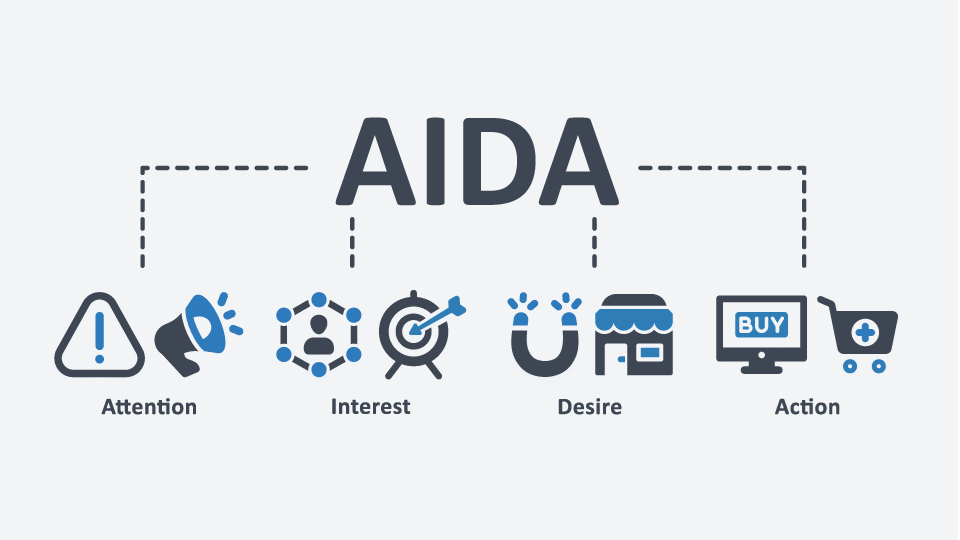
AIDA, short for Attention, Interest, Desire, and Action, is a science-based selling method, and it seeks to create a stimulus in the buyer’s mind to generate desire and get a response.
It was created in 1898 by Elmo Lewis, and it has been reviewed numerous times in recent decades. Lewis’ main goal was to optimize the sales process by catching the lead's attention, providing information about the product or service they wanted to purchase, and then converting them into paying customers.
But don’t let the year fool you. Actually, it is a really effective technique and it has been used not only for the traditional “Corporate Sales Teams” but also by many digital copywriters over the years.
AIDA is based on the “Stimulus - Response” principle, so it is used to create a stimulus in the buyer’s mind to make them ‘desire’ and then ‘buy’ a specific product or service.
This technique is a method that can be used by both the sales team and the marketing team, to guide the potential customer more successfully through the sales funnel.
Attention refers to the moment when your future buyer knows the brand or the product/service you offer. The idea is to offer something that really piques their interest, an approach that also helps your company stand out from the competition. In digital marketing, for example, it can be the creation of an interesting ad or a more attractive landing page.
After attracting the potential customer's attention, it's critical to spark interest in your offer. From this point on, the potential buyer has already entered your sales funnel, so you must create actions that help increase interest in the purchase. For this, it is very important to highlight the strengths of your product/service and how they can solve the problem your lead has.
In the third stage of the AIDA model, prospects already understand your company offers something that can really help them. However, don’t assume that this relationship occurs only with your brand. Unless it is a totally exclusive product or service, it is very likely that this potential client has also investigated other companies.
Therefore, to take them to the next stage of the buying process, you need to demonstrate that the benefits presented can only be acquired if the purchase is made with your company. Data, customer testimonials, and success stories can help you in this step.
Finally, the last stage of the AIDA model consists of "giving the push" so the prospect makes the purchase. To achieve these results, your actions could be to provide them with an offer, for example, exclusive discounts, a free trial period, money-back guarantee, etc.
You can still use mental triggers, that is, stimuli that guide a person to make a decision. A sense of urgency, like "There are only 3 pieces left" or "Offer expires in 33 minutes" - are good examples of this in action.
At this point, you probably have a general understanding of the basic framework, but how can you apply this to your digital marketing? Let’s look at each stage more in-depth to answer that question.
Today, we are bombarded with offers – digital ads, email marketing, radio commercials, etc. So, getting people’s attention and making them want to see your unique selling proposition is very important.
If you are not able to catch people's attention, you won't be able to sell anything. So you need to know what makes a customer buy a product.
One technique for capturing customer attention in AIDA is based on creating compelling titles. Here are some examples:
OK, now that we already have their attention, you need to draw them closer. To achieve this, dive deeper into their problems, and at the same time, show them that your product/service is the solution they need. Additionally, you can show them that you understand their situation and are able to empathize with them.
You could start by saying a ‘truth’ and then combine it with a problem to create “tension”:
“Vacations make you feel relaxed and contribute to better mental health. However, they are often overpriced and unaffordable.”
This is when you have to put all the meat on the grill. You have to offer prospects your solution to their problems. Your prospect has to understand that you know his problems perfectly and your solution is the best.
Remember, before making any purchase our leads are at point A, and our goal is to move them to point B. In other words, we need to know what the transformative effect of that product is. Therefore, we have to highlight how we are going to take them from point A to B.
For this, you have to highlight the benefits that they will get by making a purchase and create an irresistible offer.
This is the final part of the AIDA formula. Now is the time to create eye-catching calls to action that tell people what action to take. Some actionable words that work really well are:
These types of words should be accompanied by expressions that call for action or urgency such as "now", "today", and "free".
You can also add time-limited offers to spark urgency and "push" to act now. For instance:
People make purchase decisions when they perceive a sense of urgency and when they notice that they might miss out on an opportunity.
Another way is to add bonuses or eliminate possible objections, for example:
After reading this article you have probably noticed that this method is fully present everywhere, and I highly recommend taking advantage of AIDA in your next campaign. Here at Marketpath, we can help you guide your digital strategy to boost your website’s traffic and increase your chances of closing more sales.